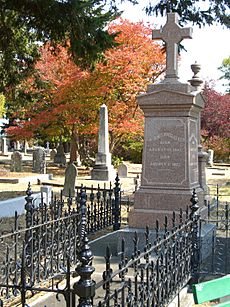Ross Bay Cemetery facts for kids

Ross Bay Cemetery
|
|
| Lua error in Module:Location_map at line 420: attempt to index field 'wikibase' (a nil value). | |
| Details | |
|---|---|
| Established | 1873 |
| Location | |
| Country | Canada |
| Type | Public (plots available by lottery) |
| Size | 27.5 acres (11.1 ha) |
| No. of graves | 27,000 |
Ross Bay Cemetery is a historic burial ground found at 1516 Fairfield Road in Victoria, British Columbia, on Vancouver Island, Canada. It's a special place where many important people from the early days of British Columbia are laid to rest.
Contents
Exploring Ross Bay Cemetery's Past
This cemetery first opened its gates in 1873. It covers about 27.5 acres, which is like 20 football fields! The cemetery is also part of a public park. Its southern side looks out over Ross Bay and the Pacific Ocean.
Who Was Isabella Ross?
The cemetery is named after Isabella Mainville Ross. She was the first independent woman in British Columbia to own land. This was a huge achievement, especially because Isabella was an Indigenous woman, from the Anishinaabe and French Métis people.
Her Métis son, Alexander Ross, was buried here in 1876. His original wooden grave marker is still around today. It's even used as a design for other old-style markers. Isabella Ross herself was buried near Alexander in 1885. Later, in 1994, a special marker was placed at her grave, just like the one she chose for her son.
Changes Over Time
In 1911, a strong wall had to be built along the ocean side. This was to stop the waves from washing away the land. In the 1930s, the city started planting many trees. This changed the cemetery from a mostly bare area to the green space you see today.
Ross Bay Cemetery has a Victorian style. You can see many fancy tombs and tall pillars, especially for people who were important long ago. Since Victoria is the capital city of British Columbia, many leaders used to live here. Because of this, many of British Columbia's former premiers (like governors or prime ministers for a province) are buried at Ross Bay.
Even though the cemetery was thought to be full, about 270 empty burial spots were found in the late 1990s. The city held a lottery to sell some of these spots. The money raised helped pay for repairs and improvements at Ross Bay Cemetery.
Famous People Buried Here
More than 27,000 people are buried at Ross Bay Cemetery. Here are some of the well-known figures:
- Billy Barker (1819–1894), a frontiersman and gold prospector.
- Robert Beaven (1836–1920), a leader and Premier of British Columbia.
- Sir Matthew Begbie (1819–1894), the first Chief Justice of British Columbia.
- Harlan Carey Brewster (1870–1918), a leader and Premier of British Columbia.
- Emily Carr (1871–1945), a famous Canadian painter.
- Nellie Cashman (1845–1925), a nurse and gold prospector.
- Sir Henry Pering Pellew Crease (1823–1905), an early Supreme Court Justice in British Columbia.
- Sarah Lindley Crease (1826–1922), an artist.
- Amor De Cosmos (1825–1897), a leader and Premier of British Columbia.
- Sir James Douglas (1803–1877), the first Governor of British Columbia.
- James Dunsmuir (1851–1920), a businessman and Premier of British Columbia.
- Roderick Finlayson (1818–1892), often called the "Father of Victoria."
- John Hamilton Gray (1814–1889), one of the "Fathers of Confederation" who helped create Canada.
- Hannah Maynard (1834–1918), a photographer.
- Sir Richard McBride (1870–1917), a leader and Premier of British Columbia.
- William Henry McNeill (1803–1875), a ship captain who helped find the location for Fort Victoria.
- Joseph Despard Pemberton (1821–1893), the Surveyor-General of Vancouver Island.
- Sophie Pemberton (1869–1959), a painter.
- John Robson (1824–1892), a leader and Premier of British Columbia.
- Isabella Mainville Ross (1807–1885), the first independent female landowner in British Columbia.
War Graves
The cemetery is also home to the graves of 135 Commonwealth service members. Most of these brave individuals died during World War I, and two during World War II.


